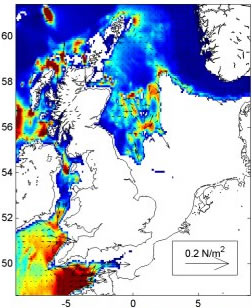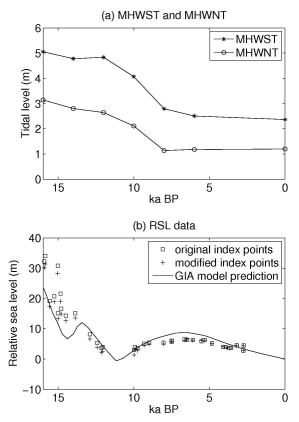
Shelf Sea Modelling Research Group
Palaeoceanographic Modelling

In collaboration with James Scourse (Bangor University) and Katsuto Uehara (Kyushu University), I have been simulating shelf-scale hydrodynamics and sediment dynamics from the Last Glacial Maximum (LGM) to the present. Due to large changes in relative sea level (of order 100 m), we have found that there has been a significant decrease in shelf-scale wave-induced bed shear stress over the last 12,000 years due to a lower amplitude of wave motion penetrating to the bed over the deeper present-day shelf seas. This has led to a considerable shift in the ratio between tidal-induced and wave-induced sediment transport over this time period. This research is continuing under the context of a NERC-funded PhD project. Sophie Ward is making use of BGS sediment cores to validate a ROMS model of the NW European shelf seas from the LGM to present.

Our latest results (Neill et al., 2010) demonstrate that over the last 16,000 years there has been an extreme change in tidal range at Arisaig, west coast of Scotland. The Arisaig record is one of the longest near-field sea level records available; as such it has been used to constrain the timing and magnitude of global deglacial meltwater events. Since this site has experienced extreme changes in reference water levels (e.g. mean high water spring tide) over the last 16,000 years, the relative sea-level curve requires correction for these palaeotidal changes, with implications for the interpretation of the glacio-eustatic component of the record. An example correction, making use of our latest results, is shown to the right. Original RSL data are from Shennan et al. (2000) Quat. Sci. Rev. 19, 1103-1135.
Relevant publications:
- Neill, S.P., Scourse, J.D., Bigg, G.R. and Uehara, K. (2009) Changes in wave climate over the northwest European shelf seas during the last 12,000 years. Journal of Geophysical Research 114, C06015.
- Neill, S.P., Scourse, J.D. and Uehara, K. (2010) Evolution of bed shear stress distribution over the northwest European shelf seas during the last 12,000 years. Ocean Dynamics 60, 1139-1156. (includes supplementary online material)

